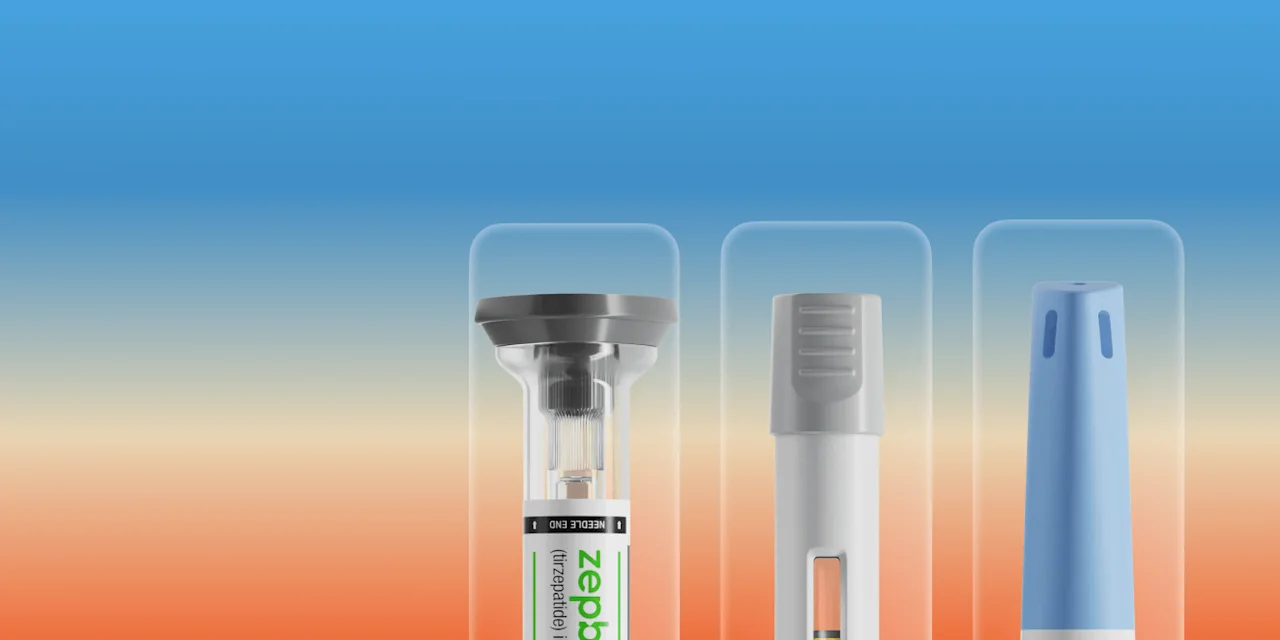Key takeaways
Pairing a slight calorie restriction with increased physical activity to create a small-to-moderate calorie deficit can be a sustainable and effective way to lose weight.
Most experts recommend a slower rate of weight loss between 1 and 2 pounds per week (4 and 8 pounds per month) over more extreme weight loss methods.
Cutting calories too drastically can harm health and lead to side effects like extreme hunger, dizziness, and irritability. This is why it’s best to avoid extreme diets.
A trusted healthcare provider can help you reach your weight loss goals by providing a personalized calorie deficit plan that’s safe and effective.
Here's what we'll cover
Key takeaways
Pairing a slight calorie restriction with increased physical activity to create a small-to-moderate calorie deficit can be a sustainable and effective way to lose weight.
Most experts recommend a slower rate of weight loss between 1 and 2 pounds per week (4 and 8 pounds per month) over more extreme weight loss methods.
Cutting calories too drastically can harm health and lead to side effects like extreme hunger, dizziness, and irritability. This is why it’s best to avoid extreme diets.
A trusted healthcare provider can help you reach your weight loss goals by providing a personalized calorie deficit plan that’s safe and effective.
If you're trying to lose weight with diet and exercise, eating in a calorie deficit may help you reach your weight loss and wellness goals.
Calories represent the amount of energy your body obtains from foods and drinks. When you’re eating in a calorie deficit, you take in fewer calories than you burn – either by eating fewer calories, increasing your activity levels, or a combination of both.
While a calorie deficit can help you lose weight, it’s important to do so in a healthy way that works best for your body. Extreme calorie restrictions can harm your health and may contribute to an unhealthy relationship with food.
This guide tells you everything you need to know about eating in a calorie deficit, including how to calculate your energy needs, safe and effective calorie deficit ranges, potential risks, and how to monitor your progress.
What is a calorie deficit?
Calories are the energy source your body uses for various functions, like breathing, walking, and digesting the food you eat.
When you consume around the same number of calories you burn every day, your body weight will generally stay the same. If you’re trying to lose weight, you may need to take in fewer calories than you burn.
This is known as a calorie deficit. For example, a person taking in 1,800 calories per day but burning 2,000 is in a calorie deficit.
When you’re in a calorie deficit, your body is forced to break down stored body fat for energy, which can lead to weight loss for some people.
A calorie deficit can be achieved in two ways:
Reducing your daily calorie intake
Increasing your energy output by being more physically active
A calorie deficit is only meant to be used for a limited time to induce weight loss. Most people follow reduced-calorie diets for several months until they reach their weight loss goals.
However, the amount of time you’ll need to spend in a calorie deficit depends on how much weight you want to lose. People who want to lose more weight may generally need to follow a lower-calorie diet for longer than those who have a smaller amount of weight to lose.
No matter if you want to drop five or 100 pounds, it’s important to choose safe and sustainable methods to do so. This includes avoiding extreme diets and instead creating a healthy, balanced eating plan based on your specific needs and preferences.
Eating in a calorie deficit isn’t about skipping meals or practicing extreme food restriction — it’s about eating nutrient-dense, whole foods to help fuel your body while you’re trying to lose weight.
This balanced approach can support steady weight loss to help you reach and maintain your goals while reducing the risk of unpleasant — or potentially harmful — side effects.
How to calculate your calorie deficit
The first step in creating a calorie deficit is determining your individual calorie needs, which vary based on factors like your age, weight, height, and activity levels.
After you figure out your average daily calorie needs, you can then subtract calories based on your weight loss goals.
There are a few ways to determine your calorie needs and calculate your calorie deficit, including using an online calorie deficit calculator, manual calculation, and working with a healthcare provider.
Using a calorie deficit calculator
Online calorie calculators can help find your total daily energy expenditure (TDEE), or the total number of calories your body burns daily, by having you plug in your height, body weight, and activity levels.
TDEE includes your basal metabolic rate (BMR), which is the energy your body uses for life-sustaining processes (e.g. breathing, circulating blood) while you’re at rest. Your BMR accounts for 60%--70% of your daily energy needs.
Once your TDEE is determined, a calculator can then determine your calorie deficit by subtracting the number of calories you should eat in a day to achieve your goal weight.
So, if you want to lose 1 pound per week, the calculator below will then subtract 500 calories from your TDEE to give you your calorie deficit (i.e. daily calorie intake to lose weight).
Manual calculation method
If you’re interested in calculating your calorie needs on your own, you can use the Mifflin St. Jeor Equation. This is a formula that uses your height, weight, and age to calculate your BMR.
Here are the equations for men and women:
Men: calories per day = 9.99 (weight in kg/kg) +6.25(height in cm/cm) –4.92 (age) +5
Women: calories per day = 9.99 (weight in kg) +6.25(height in cm) – 4.92 (age) -161
So, for a 50-year-old woman who stands at 5’6’’ and weighs 150 pounds, the equation would be:
9.99 (68 kg) +6.25(167.64 cm) – 4.92 (50) -161 = 1,320 calories per day
After determining your BMR, you then multiply this number by something called an activity factor. Activity factors are numbers that are based on your average daily activity levels — the more active you are, the greater the number:
Sedentary: x 1.2 (very little or no exercise)
Lightly active: x 1.375 (light exercise less than three days per week)
Moderately active: x 1.55 (moderate exercise most days of the week)
Very active: x 1.725 (hard exercise every day)
Extra active: x 1.9 (strenuous exercise two or more times per day)
The number you get as a result of this formula, or from using a TDEE calculator, is your TDEE. Once you’ve determined your daily energy needs, you can subtract calories from that number to create a calorie deficit.
Though the Mifflin St. Jeor equation is considered the most reliable method for calculating BMR, it’s important to note that it only gives you an estimation of your daily calorie needs and may not be exact.
This method does not account for the thermic effect of food (TEF), which is the number of calories your body uses to digest and absorb energy from foods and drinks.
TEF accounts for around 10% of your total daily energy expenditure, but it varies based on the composition of your diet. The TEF of protein, carbs, and fats are 20%–30%, 5%–10%, and 0%–3%, respectively. For example, protein takes the most energy to digest, so someone following a high-protein diet will burn more calories than someone following a lower-protein diet.
Find out your daily calorie needs
Quickly calculate your total daily energy expenditure to optimize your diet, fitness, and weight goals.
Maintain your current weight
----
CAL DAILY
Lose one pound per week
----
CAL DAILY
This TDEE calculator is for informational purposes only and not a substitute for medical advice. Individual needs vary. Consult a healthcare provider before making changes. Eating fewer than 1,200 (women) or 1,500 (men) calories a day is not recommended.
Seeking professional guidance
If you don’t feel comfortable calculating your energy needs and creating a calorie deficit on your own, a healthcare provider may be able to offer more guidance.
Registered dietitians (RDs) and certain healthcare professionals, such as obesity specialists, can help calculate your energy requirements and develop a custom weight loss plan tailored to your goals and health needs.
“An RD can help identify some key areas in your diet where calories can be decreased while ensuring you still get plenty of protein, fiber, healthy fats, and micronutrients,” says Daniel Preiato, RD, CSCS.
In some cases, medical professionals may have access to more accurate methods for determining calorie needs, such as indirect calorimetry, which measures both your oxygen consumption and carbon dioxide production during a set period. Indirect calorimetry is considered the “Gold Standard” for measuring calorie needs and is more accurate than online calculators or equations like Mifflin St. Jeor.
How to create a calorie deficit
To create a calorie deficit, you’ll need to reduce your calorie intake, increase your energy expenditure, or try a combination of both.
Pairing a smaller calorie reduction (about 250 fewer calories per day) with increased physical activity may be a more sustainable option, and can help you feel less restricted in your diet. Plus, adding in or increasing physical activity can help improve other aspects of overall wellness, like heart health and mental health.

Diet considerations and tactics
When you’re trying to lose weight, choosing a healthy dietary pattern is key for helping you meet your goals. Increasing your intake of nutritious and filling foods high in protein and fiber and reducing your intake of highly processed foods can help you stick to your updated daily calorie goals.
Although it’s not necessary to follow a specific diet, certain ways of eating have been shown to enhance weight loss and reduce hunger levels.
Increase your protein intake
Protein can support weight loss by slowing digestion, stimulating the release of satiety hormones, and decreasing appetite — which can all make eating in a calorie deficit easier. High-protein foods include chicken, Greek yogurt, legumes, and seafood.
Following a high-protein diet may also help preserve muscle mass in a calorie deficit. A 2024 review of 28 studies found that increased protein intake significantly prevented muscle mass decline in adults with overweight or obesity who were trying to lose weight.
Maintaining muscle mass is important for long-term weight loss maintenance as it can help preserve your BMR (the number of calories you burn at rest). Studies show that people who are trying to lose weight while gaining or maintaining their muscle mass need between 1-1.4 grams of protein per pound of body weight per day.
Eat more fiber-rich foods
Like protein, fiber increases feelings of fullness, which can help you eat fewer calories. High-fiber foods include beans, fruits, vegetables, nuts, seeds, and whole grains. Men need between 30-38 grams of fiber per day, while women need between 21-25 grams per day, depending on age.
Prioritize whole foods
Cutting back on ultra-processed foods — which are high in added sugar, refined carbs, and sodium — and opting for whole foods rich in protein, fiber, and healthy fats can reduce hunger levels and may decrease the need for snacking.
Exercise and fitness in a calorie deficit
Getting regular exercise is critical for overall health, including the function of your heart and lungs. Increasing physical activity is an excellent way to improve your fitness levels, reduce disease risk, and torch some extra calories.
You don’t have to sign up for intensive workout classes or join an expensive gym to get in an effective, calorie-burning workout. Walking, jogging, and yoga are just a few examples of exercises you can do on your own for free.
Increasing your daily steps is one of the best ways to create a calorie deficit. Walking is accessible for most people and is a low-impact, beginner-friendly activity. You can track your energy output by keeping track of your steps with a FitBit or your smartphone. Studies show that you burn around one calorie for every 20 steps you take. A mile is roughly 2,000 steps, so walking three miles a day (6,000 steps) could burn around 300 calories.
If your current activity levels are low, start by tracking your steps and taking one or two daily walks to create a calorie deficit.
Preiato also recommends adding resistance training whenever possible. “In my experience, resistance training is vital to the weight loss process,” he says. “It helps you maintain or increase muscle mass, in turn increasing your BMR and allowing you to burn calories more efficiently.”
Safe and effective calorie deficit ranges
It can be tempting to try to lose weight quickly by creating a large calorie deficit, but most experts recommend a slower rate of weight loss between 1-2 pounds per week (or about four to eight pounds per month).
Creating a smaller calorie deficit and losing weight at a slower, steadier rate may also make it easier to maintain your diet and fitness plan.
“Research suggests that a moderate calorie deficit is much more sustainable for the long term when compared with very low-calorie diets,” Preiato says. “You may see great results on a very low-calorie diet initially, though they can be quite hard to stick to when your natural hunger cues prevail.”
For some people, a calorie deficit of around 500 calories per day may equate to a weight loss of about 1 pound a week or 4 pounds a month.
To get to this calorie deficit, you could deduct 500 calories from your current calorie intake. Or you could use a combination of reduced calorie intake and increased energy expenditure via regular exercise. For example, you might try a 250/250 method by cutting 250 calories per day and increasing your daily energy expenditure by 250 calories. This combination approach may help the calorie reduction feel more gradual and sustainable.
How long it takes a person to burn calories depends on factors like age, weight, and other health conditions, but some ways to burn 250 calories might include:
30 minutes of cycling
30-60 minutes of brisk walking or dancing
30-40 minutes of lap swimming
20-30 minutes of high-intensity interval training (HIIT)
When figuring out how many calories to deduct each day, it’s crucial to understand that cutting your calories too drastically can lead to unpleasant and even potentially dangerous side effects like extreme hunger, dizziness, and fainting.
Extreme calorie restriction can also lead to compensatory changes in your body. If you cut too many calories too quickly, your body may respond by slowing down your metabolism or making other changes to help counteract the calorie deficit. This may include muscle loss, increased appetite, and reductions in BMR, which can make it harder to maintain weight loss long term.
This is why it’s best to create smaller calorie deficits and to avoid diets that are very low in calories, such as those that provide less than 1,200 calories per day.
When you’re eating in a calorie deficit, pay attention to how you feel. If you find that you have low energy levels or are experiencing dizziness, headaches, or intense hunger, you may need to increase your calorie intake.
Common mistakes to avoid
There are a few common mistakes that many people make when eating in a calorie deficit. These can increase the risk for unpleasant complications and may also make weight loss harder.
Eating too few calories. Cutting out too many calories can lead to extreme hunger, nutrient deficiencies, low mood, and decreased BMR, which can make it harder for you to reach your wellness goals.
Neglecting protein. Protein helps keep you full and is important for maintaining muscle mass. Inadequate protein intake can lead to muscle loss during weight loss, which negatively decreases your metabolic rate.
Being too strict. Research suggests that being overly strict with your diet and avoiding certain foods can increase cravings. Studies also show that people who are overly restrictive with their diet are more likely to overeat highly palatable foods, like sweets and processed foods, than people who take a more flexible approach to eating.
Focusing on diet only. While diet is important when it comes to weight loss, other factors — like regular exercise, staying hydrated, and getting enough sleep — are crucial for overall health and body weight maintenance.
Monitoring progress and adjusting your calorie deficit
To design and maintain a calorie-deficit meal plan, you’ll need to keep track of your calorie intake and energy expenditure. While calorie and activity tracking isn’t meant to be done long term, it can help you stay on track when you’re in a calorie deficit.
You can use an app like MyFitnessPal to track your calories and activity to ensure you’re hitting your daily goals. It can also help you stay within set macronutrient ranges, such as a high-protein eating pattern.
While calorie-tracking apps can be helpful in the short term, it’s important to note that their use may trigger or worsen disordered eating behaviors in some people. Therefore, it’s important to only track your calories when necessary.
If you find yourself in a weight loss plateau or aren’t achieving your body composition goals, you may have to adjust your calorie intake or energy output. A healthcare provider, like one through Ro or a registered dietitian, can help you work through any setbacks you encounter and provide personalized recommendations based on your progress.
Potential benefits of a calorie deficit beyond weight loss
In addition to weight loss, changing up your diet may help improve health in other ways. Losing excess body fat can reduce the number of risk factors for chronic diseases, like type 2 diabetes, elevated blood lipid levels, and high blood pressure.
For example, research findings suggest that type 2 diabetes risk is reduced by 16% for every kilogram (2.2 pounds) of weight lost in people with overweight or obesity who have prediabetes.
Eating a variety of nutrient-dense foods can also help boost your intake of vitamins, minerals, protein, and healthy fats. These changes can improve the overall quality of your diet, which may enhance mental and physical health.
Potential risks of a calorie deficit
Though losing weight by eating in a calorie deficit can improve health in several ways, cutting calories too drastically comes with risks.
“Cutting calories too much leaves you susceptible to various nutrient deficiencies, the most common being vitamin D, calcium, magnesium, iron, and B12,” Preiato says. “ Some other downsides include fatigue, muscle loss, moodiness, excessive hunger, and sleep disruptions.”
Additionally, taking in too few calories can negatively impact your BMR, which can make weight loss harder to maintain over time.
When you’re eating in a calorie deficit, it’s important to watch out for signs that you may be under consuming calories, such as:
Feeling dizzy upon standing
Tiredness or low energy
Extreme hunger
Mood changes
These may be signs that you need to increase your calorie intake or scale back on your workout schedule.
Choosing a smaller calorie deficit can help to prevent these potential side effects. Though it may result in slower weight loss, a smaller reduction in calories can support safer weight loss and set you up for long-term success.
If you’re underweight, have an eating disorder (or a history of disordered eating), or are pregnant or nursing, it’s best to avoid cutting calories or following a weight loss plan unless specifically recommended by a healthcare provider.

When to seek medical advice
While eating in a calorie deficit can be an effective and safe way for some people to drop extra body fat, weight loss may still be a struggle for some. If you find it hard to lose weight even when eating in a calorie deficit and exercising more, talk to your healthcare provider.
Certain health conditions, like hypothyroidism and polycystic ovarian syndrome (PCOS), can make weight loss harder due to their impact on metabolism, hormones, appetite regulation, and more. A healthcare provider can rule out these and other conditions that impact body weight and recommend other treatment options if needed, including weight loss medications.
It’s also a good idea to talk to a healthcare provider if you’re experiencing side effects like extreme hunger, mood changes, or fatigue.
A healthcare provider can diagnose any underlying health issues and help you design a safe, sustainable diet and wellness plan specific to your health needs and goals.
Bottom line
Eating in a calorie deficit may help you lose weight and reach your body composition goals. But it’s crucial to choose a healthy and safe diet plan that provides your body with enough calories and covers your nutritional needs.
Create a calorie deficit by pairing a small to moderate calorie reduction (250-500 fewer calories per day) with increased exercise. This can help make your plan easier to stick to long term and set you up for success.
Try the 250/250 approach by cutting 250 calories per day and burning 250 calories with 30 minutes of cycling, swimming, or brisk walking. This will help create a calorie deficit of around 500 calories per day, which may lead to a weight loss of about 1 pound a week or 4 pounds a month.
Avoid extreme diets that provide less than 1,200 calories per day. These drastic calorie restrictions can cause potentially harmful side effects, create an unhealthy relationship with food, and may even make weight loss more difficult.
Creating a smaller calorie deficit and losing weight at a slower, steadier rate may help prevent compensatory changes that make long-term weight maintenance difficult, like muscle loss, increased appetite, and reductions in BMR, which often occur when following very low-calorie diets.
Some people may need additional support. A healthcare provider can rule out underlying health issues that make weight loss difficult and give personalized recommendations for diet, exercise, and medications if needed.
Frequently asked questions (FAQs)
How do I figure out my calorie deficit?
Figuring out your calorie deficit involves calculating your total daily energy expenditure (TDEE) and then subtracting calories from that number to get your daily calorie allowance.
You can use online calorie calculators or assess your calorie needs using the Mifflin St. Jeor equation.
What is a good calorie deficit?
A calorie deficit of around 500 calories per day will equate to a weight loss of about 1 pound a week, or 4 pounds a month. You can reach this deficit by decreasing your daily calorie intake by 250 calories and increasing your energy output to burn an additional 250 calories a day.
What is an appropriate calorie deficit for weight loss?
Most experts recommend a slower rate of weight loss between 1 and 2 pounds per week (4 and 8 pounds per month). This equates to a daily calorie deficit of 500-1,000 calories, but remember that this is just an estimate. Factors like age, weight, activity levels, and other health conditions will help inform what is a safe and appropriate calorie deficit for you.
DISCLAIMER
If you have any medical questions or concerns, please talk to your healthcare provider. The articles on Health Guide are underpinned by peer-reviewed research and information drawn from medical societies and governmental agencies. However, they are not a substitute for professional medical advice, diagnosis, or treatment.
References
Akbar, A., & Shreenath, A. P. (2025). High fiber diet. StatPearls. Retrieved from http://www.ncbi.nlm.nih.gov/books/NBK559033/
Alexander, L., Christensen, S. M., Richardson, L., et al. (2022).Nutrition and physical activity: An Obesity Medicine Association (OMA) Clinical Practice Statement 2022. Obesity Pillars, 1, 100005. doi: 10.1016/j.obpill.2021.100005. Retrieved from https://pubmed.ncbi.nlm.nih.gov/38085928/
Amaro-Gahete, F. J., Jurado-Fasoli, L., Ruiz, J. R., et al. (2020). Association of basal metabolic rate and nutrient oxidation with cardiometabolic risk factors and insulin sensitivity in sedentary middle-aged adults. Nutrients, 12(4), 1186. doi: 10.3390/nu12041186. Retrieved from https://pmc.ncbi.nlm.nih.gov/articles/PMC7230721
Calcagno, M., Kahleova, H., Alwarith, J., et al. (2019). The thermic effect of food: A review. Journal of the American College of Nutrition, 38(6), 547–551. doi: 10.1080/07315724.2018.1552544. Retrieved from https://www.tandfonline.com/doi/full/10.1080/07315724.2018.1552544
Dabas, J., Shunmukha Priya, S., Alawani, A., et al. (2024). What could be the reasons for not losing weight even after following a weight loss program? Journal of Health, Population, and Nutrients, 43(1), 37. doi: 10.1186/s41043-024-00516-4. Retrieved from https://pmc.ncbi.nlm.nih.gov/articles/PMC10908186/
Delsoglio, M., Achamrah, N., Berger, M. M., et al. (2019). Indirect calorimetry in clinical practice. Journal of Clinical Medicine, 8(9), 1387. doi: 10.3390/jcm8091387. Retrieved from https://www.mdpi.com/2077-0383/8/9/1387
Dwyer, J. T., Melanson, K. J., Sriprachy-anunt, U., et al. (2015). Dietary treatment of obesity. In: Feingold KR, Anawalt B, Blackman MR, et al., eds. Endotext. MDText.com, Inc.; 2000. Retrieved from https://www.ncbi.nlm.nih.gov/books/NBK278991/
Eikey, E. V. (2021). Effects of diet and fitness apps on eating disorder behaviours: Qualitative study. BJPsych Open, 7(5), e176. doi: 10.1192/bjo.2021.1011. Retrieved from https://pmc.ncbi.nlm.nih.gov/articles/PMC8485346/
Hall, K.D. & Kahan, S. (2018). Maintenance of Lost Weight and Long-Term Management of Obesity. The Medical Clinics of North America, 102(1), 183-197. doi: 10.1016/j.mcna.2017.08.012. Retrieved from https://pmc.ncbi.nlm.nih.gov/articles/PMC5764193/
Hansen, T. T., Astrup, A., & Sjödin, A. (2021). Are Dietary Proteins the Key to Successful Body Weight Management? A Systematic Review and Meta-Analysis of Studies Assessing Body Weight Outcomes after Interventions with Increased Dietary Protein. Nutrients, 13(9), 3193. doi: 10.3390/nu13093193. Retrieved from https://pubmed.ncbi.nlm.nih.gov/34579069/
Janssen, T. A. H., Every, D. W. V., & Phillips, S. M. (2023). The impact and utility of very-low-calorie diets: The role of exercise and protein in preserving skeletal muscle mass. Current Opinion in Clinical Nutrition and Metabolic Care, 26(6), 521. doi: 10.1097/MCO.0000000000000980. Retrieved from https://pmc.ncbi.nlm.nih.gov/articles/PMC10552824/
Kokura, Y., Ueshima, J., Saino, Y., et al. (2024). Enhanced protein intake on maintaining muscle mass, strength, and physical function in adults with overweight/obesity: A systematic review and meta-analysis. Clinical Nutrition ESPEN, 63, 417–426. doi: 10.1016/j.clnesp.2024.06.030. Retrieved from https://pubmed.ncbi.nlm.nih.gov/39002131/
Meule, A. (2020).The Psychology of Food Cravings: the Role of Food Deprivation. Current Nutrition Reports, 9(3), 251-257. doi: 10.1007/s13668-020-00326-0. Retrieved from https://pmc.ncbi.nlm.nih.gov/articles/PMC7399671/
Most, J., & Redman, L. M. (2020). Impact of calorie restriction on energy metabolism in humans. Experimental Gerontology, 133, 110875. doi: 10.1016/j.exger.2020.110875. Retrieved from https://pubmed.ncbi.nlm.nih.gov/32057825/
Osilla, E. V., Safadi, A. O., & Sharma, S. (2025). Calories. StatPearls. Retrieved from http://www.ncbi.nlm.nih.gov/books/NBK499909/
Polivy, J.,& Herman, C. P. (2020). Overeating in Restrained and Unrestrained Eaters. Frontiers in Nutrition, 7, 30. doi: 10.3389/fnut.2020.00030. Retrieved from https://pmc.ncbi.nlm.nih.gov/articles/PMC7096476
Si, K., Hu, Y., Wang, M., et al. (2022). Weight loss strategies, weight change, and type 2 diabetes in US health professionals: A cohort study. PLoS Medicine, 19(9), e1004094. doi: 10.1371/journal.pmed.1004094. Retrieved from https://pmc.ncbi.nlm.nih.gov/articles/PMC9514663/
Stokes, T., Hector, A. J., Morton, R. W., et al. (2018). Recent perspectives regarding the role of dietary protein for the promotion of muscle hypertrophy with resistance exercise training. Nutrients, 10(2), 180. doi: 10.3390/nu10020180. Retrieved from https://www.mdpi.com/2072-6643/10/2/180
Stubelj, M., Teraž, K., & Poklar Vatovec, T. (2019). Predicting Equations and Resting Energy Expenditure Changes in Overweight Adults. Slovenian Journal of Public Health, 59(1), 33-41. doi: 10.2478/sjph-2020-0005. Retrieved from https://pmc.ncbi.nlm.nih.gov/articles/PMC7478086/
Thom, G., Gerasimidis, K., Rizou, E., et al. (2020). Validity of predictive equations to estimate RMR in females with varying BMI. Journal of Nutritional Science, 9, e17. doi: 10.1017/jns.2020.11. Retrieved from https://pmc.ncbi.nlm.nih.gov/articles/PMC7299486/
Trexler, E. T., Smith-Ryan, A. E., & Norton, L. E. (2014). Metabolic adaptation to weight loss: implications for the athlete. Journal of the International Society of Sports Nutrition, 11(1), 7. doi: 10.1186/1550-2783-11-7. Retrieved from https://pubmed.ncbi.nlm.nih.gov/24571926/
Yang, S., Zhou, Z., Miao, H., et al. (2023). Effect of weight loss on blood pressure changes in overweight patients: A systematic review and meta-analysis. Journal of Clinical Hypertension (Greenwich), 25(5), 404-415. doi: 10.1111/jch.14661. Retrieved from https://pmc.ncbi.nlm.nih.gov/articles/PMC10184479/













